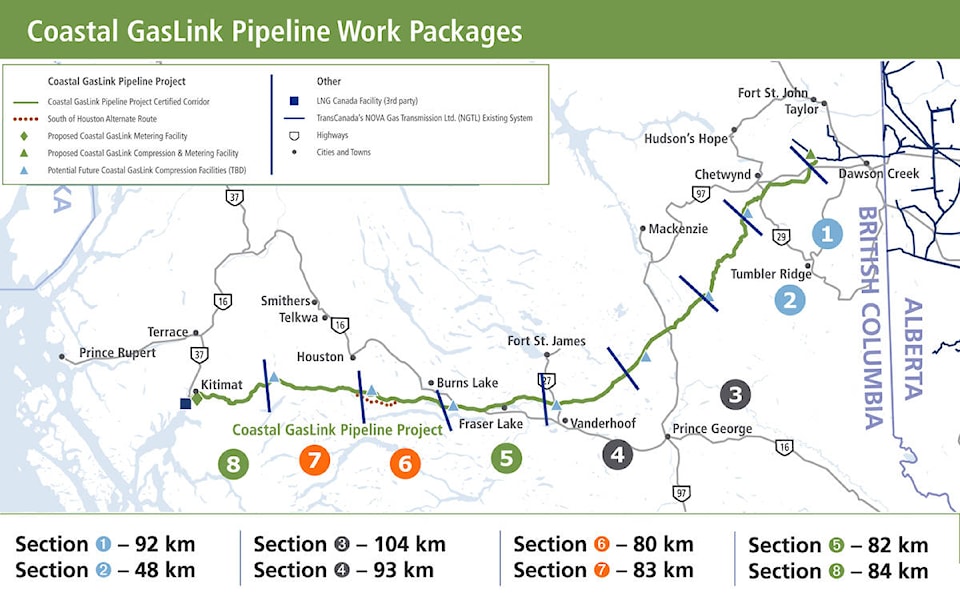Area businesses gathered in Terrace Nov. 27 for an all-day session outlining contract opportunities arising from the construction of the western end of the Coastal GasLink natural gas pipeline which will feed LNG Canada’s liquefaction facility at Kitimat.
At 670 kilometres long, beginning in the northeastern B.C. gas fields, the Coastal GasLink project is worth $6.2 billion and is divided into eight sections, each roughly 80km long.
This western-most section, called Section 8, is being built by the Macro-Spiecapag Joint Venture. Its representatives were at the meeting along with those from Coastal GasLink and subcontractors.
READ MORE: Natural gas pipeline cost soars
Coastal GasLink, a subsidiary of TransCanada, has already signed contracts worth $620 million with First Nations ventures connected to First Nations territorial interests along the pipeline route.
These contracts primarily cover route clearing, medical services, security and construction camp activities with Macro-Spiecapag and other specialized companies doing the actual laying of the 48-inch diameter gas pipeline.
For this western-most 84 kilometre section of the pipeline, Coastal GasLink has economic benefits agreements with the Kitselas First Nation, the Haisla Nation, the Witset First Nation near Smithers and the Wet’suwet’en First Nation and Skin Tyee Nation in the Lakes District area.
In addition to the $620 million for Indigenous-designated contracts, there’s an additional $400 million in contract opportunities tied to the pipeline construction work.
Each of these pipeline sections will require hundreds of workers at peak construction. They will be housed in 14 camps of various sizes for varying lengths of time. One of the largest on this end of the route is the Sitka Lodge in Kitimat, belonging to work camp provider Civeo.
It’s located just off Lahakas Boulevard near the Kitimat General Hospital and now has 646 rooms, expanding to 1,100 in the new year, Civeo stated in a late October press release.
It’s partnering with the Haisla and its accommodation provision contract covers 18 months with an option to extend to 36 months.
Civeo is one of four prime work camp providers hired by Coastal GasLink and at the construction peak, 600 workers will be staying at the Sitka camp for roughly six to eight months.
There’s a second large camp also to be constructed in this area. Called Pioneer 4 and to be located in the Clore River area approximately 60 kilometres from Kitimat, it’s the responsibility of camp provider ATCO/ESS, another joint venture, and will have a peak capacity of approximately 350 people.
Two other smaller camps for approximately 35 workers each are also being planned in the area.
Additionally, two other construction camps are to be built toward the Houston end of Section 8 with two more camps located in the vicinity of Houston for Section 7. One of those is to house 450 people at peak capacity and the other 300 people. These are Civeo camps as well.
“Regardless of the area or size, safety of the workers in the camp and the nearby communities is paramount,” says Coastal GasLink official Jacquelyn Benson in an email.
“TransCanada and its contractors will work with local law enforcement, fire and emergency services to develop emergency response plans and share information on the project and activities in the area,” she says.
“It’s in our interests to ensure that the camps are professionally run and respectful to the communities they neighbour.”
Clearing and other work along the pipeline route will begin in 2019 with activity increasing in intensity in 2020 and 2021.
Macro-Spiecapag is also building a second section of the pipeline of 82km located roughly between Burns Lake and Vanderhoof with both sections carrying a value of more than $900 million.
A number of the Sitka Lodge rooms are also being set aside for workers assigned to the initial construction phase of the LNG Canada facility.
